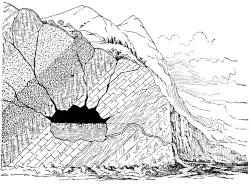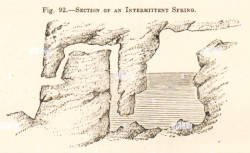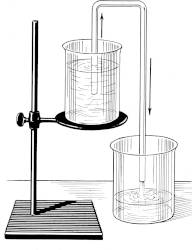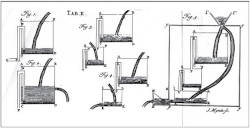Intermittent Spring
Ebb and Flow Springs - Rhythmic Karst Springs - Potajnice
ebb and flow spring, ebbing and flowing well, tidewell.
A spring or flowing well exhibiting periodic variation in volume of flow; the periodicity, which is often irregular, is attributed to siphonic action.
Watson Hiner Monroe (1970):
A Glossary of Karst Terminology, Geological Survey Water-supply Paper 1899-k, Library of Congress catalog-card No. 75-607530
DOI
online




Intermittent Spring refers to a spring that goes dry regularly with a very short frequency, which means minutes, hours or probably days. Such springs pour normally, then the flow decreases until it stops completely and then starts again and returns to full strength after a certain time. The discharge roughly follows a sinusoidal function, whereby frequency and amplitude are subject to seasonal fluctuations. Typical duration for a period, i.e. a complete run, is in the hour range. Actually there are three types of such springs, only one is karst related. The other two are geysers, caused either by heat or by gas like carbon dioxide. However, we are here for the karst springs.
This unusual behaviour is explained by a simple theory: a cavity in the mountain (a cave) has an outlet through a siphon, which is bent upwards, not downwards. The cavity fills up until the siphon is completely full of water. Now the water in the drain branch draws water out of the cave lake until the lake level has dropped to the drain branch and air enters the siphon. The effect stops and the water flows out on both sides of the siphon. Then the cycle starts all over again. The duration depends on the size of the cavity, the height difference in the siphon and the inflow.
- permanent rhythmic springs: the intermittent action continues the whole time but the length of the period changes with the water supply, since this determines the duration until the basin is full.
- seasonal rhythmic springs:
- occurring during the rainy season: if the inflow is higher than the possible outflow, the high water level the siphon becomes continually flooded. Such springs are intermittent only at low and mean water levels.
- occurring during the dry season: if the cave chamber is not watertight and the inflow of water is small the siphon will not be filled. In this case the spring is continually dry during low water levels and becomes intermittent at mean and high water levels.
- occasionally rhythmic springs: the combination of very high inflow at some times and alternative outflow, which is actually the combination of the last two, results in an intermittent spring only at mean water level. During high water levels it flows continually, during low water levels it is completely dry.
As karst is very responsive to seasonal changes in precipitation, seasonal rhythmic springs are the most common type. In other words, most springs will appear quite normal when you visit them, to see the effect you have to visit at the right time of the year, and the weather should be right too.
The basic principle is quite simple and has many uses. For example, you can use a garden hose to drain water from a barrel or to fetch petrol from a fuel tank. It is also used in washing machines for the fabric softener: as long as the fill quantity is below the limit, the fabric softener remains in the container. However, as soon as it is rinsed by the machine, a small siphon fills up and finally sucks the container empty. And this principle is known for a long time, the oldest use is probably Pythagoras’ Cup, if you fill it normally it works well, but if you are greedy and pour too much it will empty and all the wine is gone.
This type of source is so rare that we listed only about half a dozen. According to Gavrilovic (1985) there are only about 30 intermittent springs worldwide, 20 of them in Slovenia. Later the number was estimated 100 worldwide. However, research never stalls and there might be more known by now, for example in southeast Asia which was almost unexplored at that time. We have given some examples, but most are quite unsatisfactory because they are either not freely accessible, the effect only occurs under certain conditions, or has ceased at some point, for example due to mining activity. We therefore only recommend the Fontaine de Fontestorbes, the Intermittent Spring and the Palfauer Wasserloch.
Literature
- Ognjen Bonacci, Davor Bojanic (1991): Rhythmic karst springs, Hydrological Sciences - Journal - des Sciences Hydrologiques, 36,1,2V1991 researchgate DOI
- Xianxuan Xiao, Qiang Zhang (2021): Physical and analytical modeling of rhythmic karst springs, Journal of Cave and Karst Studies, v. 83, no. 3, p. 109-119. pdf DOI
 Fontaine de Fontestorbes, France
Fontaine de Fontestorbes, France Wasserlochklamm, Austria
Wasserlochklamm, Austria Search DuckDuckGo for "Ebb and Flow Spring"
Search DuckDuckGo for "Ebb and Flow Spring" Rhythmic spring - Wikipedia (visited: 28-OCT-2022)
Rhythmic spring - Wikipedia (visited: 28-OCT-2022)
 Index
Index Topics
Topics Hierarchical
Hierarchical Countries
Countries Maps
Maps